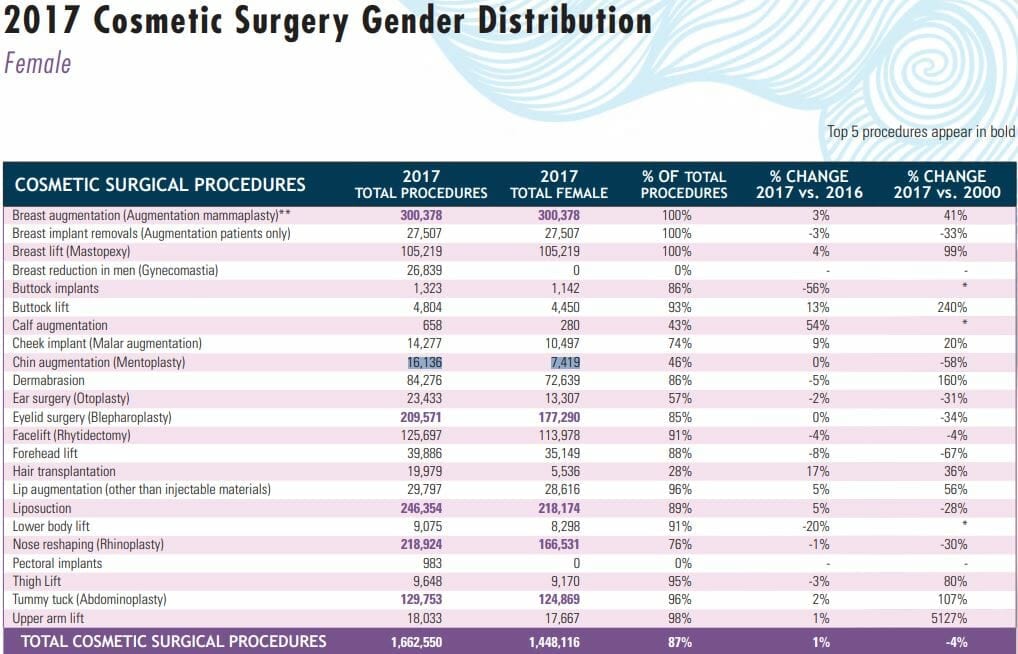Chin Implants – Know Your Options
Considering chin implants? With the constant connection to social media today, it’s easy to understand why. People are continually exposed to photos and images of themselves and those they are close to.  Whether deciding your best profile picture or Skyping with family, it’s easier than ever to be constantly reminded of your least favorite facial feature. While no one wants to look like Jay Leno per se, a chin that’s too weak or underdeveloped, or conversely too prominent, can wreak turmoil on one’s self-esteem. An under or over-defined chin can throw off a person’s facial symmetry and cause other facial features to seem disproportionate. Fortunately, chin implants and/or chin surgery, paired with the experience and vision of a board-certified plastic surgeon like Aristocrat Plastic Surgery’s Dr. Kevin Tehrani, you can still get the chin you wish you were born with.
Whether deciding your best profile picture or Skyping with family, it’s easier than ever to be constantly reminded of your least favorite facial feature. While no one wants to look like Jay Leno per se, a chin that’s too weak or underdeveloped, or conversely too prominent, can wreak turmoil on one’s self-esteem. An under or over-defined chin can throw off a person’s facial symmetry and cause other facial features to seem disproportionate. Fortunately, chin implants and/or chin surgery, paired with the experience and vision of a board-certified plastic surgeon like Aristocrat Plastic Surgery’s Dr. Kevin Tehrani, you can still get the chin you wish you were born with.
What is Genioplasty:
Genioplasty (sometimes referred to as mentoplasty) or chin surgery is the surgical procedure to change or enhance the appearance of the chin. A stronger, more defined jawline is on the rise in both men and women alike. While more men had genioplasty in 2017, cosmetic chin surgery is on the rise with women who desire a more prominent jawline as well. With more than 16,000 surgeries performed in 2017, genioplasty is quickly gaining popularity, becoming the go-to procedure to give individuals the profile and definition they so desire. Performed as an outpatient procedure and typically under general anesthesia, chin augmentation can help restore confidence to the patient, with long-term, lasting results.

Source: Plasticsurgery.org
Types of Genioplasty:
Typically genioplasty or chin surgery is performed using one of two methods, a sliding genioplasty or chin implants. Which procedure is best for you will depend on your desired outcome and facial structure, as well as the degree of your chin irregularity.
Chin Implants and Chin Reductions
During a chin implant procedure, a plastic surgeon places an alloplastic (usually made of silicone or other medical grade material) implant in the chin. Chin implant surgery is less complex than a sliding genioplasty and can be performed by most board-certified plastic surgeons.
Usually performed under general anesthesia as an outpatient procedure, the implant is inserted through the mouth (via an incision made internally, near the gum line) or under the chin and placed in a pocket created under or around the tissues surrounding the chin. Once the implant placed, the doctor will use dissolvable sutures to close the incision and bandages are applied around the face to minimize swelling and bleeding, as well as to keep everything in place during the healing process.
Some patients with larger chins may find that they benefit from chin reduction surgery. This procedure is performed similarly to a chin implant in regards to process, incisions, and recovery time. Once the incision is made, the surgeon is able to shave off and/or remove excess bone and tissue resulting in a slimmer chin and jawline.
Chin Implants Recovery Time
We recommend at least a week off of work or other commitments while you heal. Swelling, soreness and bruising are expected after surgery initially. You will also be advised to rinse your mouth with an antiseptic rinse following every meal to keep the incision site clean and lower your chance of infection. Most of our chin implant patients report being able to return to regular activities 2-3 weeks following surgery. You should allow yourself proper time to recover fully and discuss with your plastic surgeon when you may begin rigorous activities such as exercise.
Sliding Genioplasty
If your jawline as a whole receding, causing you to have a weak chin, you may be a candidate for a procedure called a sliding genioplasty. A less common surgery than chin implants but it may be recommended by a board-certified plastic surgeon or maxillofacial surgeon to help define and bring structure to an otherwise under or overdeveloped jawline.
Sliding genioplasty’s name derives from the surgeon physically sliding the patient’s chin bone forward (or backward) and repositioning it in a more symmetrical and desirable place on the face. An incision is made into the patient’s chin bone allowing access to the bone and structure of the chin. From there, the chin is either pulled forward or pushed back, whichever is needed to restore balance to facial structure. When the chin is slid forward, it can also add more projection to a patient’s lips, causing more overall facial symmetry. Whether the chin is pulled forward or pushed back, it is typically held in place with titanium screws so the bones are securely repositioned permanently.
Incisions are made on the lower lip, near the gumline, so no visible scars are present. The surgeon can access the chin bone directly and decide where to reposition the bone. In some cases, your surgeon may decide to place a titanium plate on your chin bone to help with projection, which is secured with small screws. Incisions are closed with dissolvable, temporary sutures.
Performed under general anesthesia as an outpatient procedure, sliding genioplasty is a more in-depth surgery than chin implants alone. Reserved for patients with more severe chin imperfections, this procedure can offer the most dramatic results.
Sliding Genioplasty Recovery Time
Immediately following a sliding genioplasty, swelling, soreness, and bruising are to be expected, however, sliding genioplasty recovery is not much different than chin implant surgery. Recovery is generally between 2-3 weeks with patients usually able to return to regular activities after one week.
As with all cosmetic procedures, there are risks involved although they are minimal with genioplasty. Some complications can include discomfort or pain for several weeks following your surgery. A small percentage of patients may experience slight nerve damage which may be permanent. The risk is minimal although it could cause numbness in the lower lip and chin area.
Once we perform a free initial consultation in either our Great Neck or Manhattan offices, Dr. Tehrani can better assess which procedure will give you the best outcome and help set realistic expectations. Depending on your facial structure, a genioplasty may be performed in conjunction with rhinoplasty, face-lift, or liposuction in the chin and neck area to help balance the face. Chin augmentation performed with a face-lift or liposuction can add more definition to the jawline for an overall slimmer, more defined face.
Candidates for Genioplasty
Candidates for genioplasty are generally over the age of 18 (the age that the mandible – jawbone – has finished growing and thickening of the jaw is complete), in overall good health, and can refrain from smoking 4-6 weeks prior to and after surgery. Patients are also advised to stop using aspirin products 14 days before and after their procedure so that bleeding risks are minimized.
When deciding if any cosmetic procedure is for you, it is important to research extensively before going under the knife. We recommend reading about genioplasty as well as viewing chin implant before and after galleries to understand what you should expect. Finding a board-certified plastic surgeon or maxillofacial surgeon is imperative in your cosmetic journey to minimize risk and after your procedure.
Of course, the only way to know for certain if you are a good candidate for chin augmentation is to see a plastic surgeon for a consultation. We are pleased to offer patients considering genioplasty a free initial consultation to decide if this procedure is right for them.
Genioplasty Vs. Fillers
Fillers are the most popular and common type of cosmetic procedure performed in the US today. With over 7.2 million Americans getting Botox alone in 2017, it’s no wonder a patient would want to consider all of their options when deciding on chin augmentation. However, there are a few considerations to be aware of when deciding which option is right for you.
No injectable filler is permanent, we all know this too well after observing our reflections months after Botox and notice the lines creeping back up. Fillers are a temporary solution as it is broken down and reabsorbed by the body, usually lasting roughly 6 months and up to 2-5 years. While some patients may find this desirable, as the upfront financial costs are lower than surgery and downtime is minimal, it is important to note that your results with filler alone will not provide an accurate depiction of what you could look like with a more complex surgical procedure, such as genioplasty. Fillers are also great for minor, temporary changes, but won’t result in the dramatic result which most patients contemplating genioplasty are looking for.
If cost is causing you to consider fillers instead of a permanent solution, like genioplasty, please let us know at your consultation. At Aristocrat Plastic Surgery and MedAesthetics we are happy to provide financing options, such as Care Credit to help you pay for your procedure.
Final Chin Implant Considerations
No one wants to feel self-conscious and with options such as genioplasty, no one has to. Come to our offices in Great Neck or Manhattan and talk to our staff, along with board-certified plastic surgeon, Dr. Tehrani. We can help you decide on which procedure is best suited for you along with setting expectations. Let us help you keep your chin up and end the wait to restore the natural beauty and symmetry of your face.

